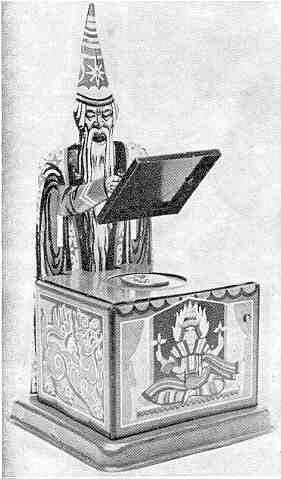Magie Bank
by F.H. Griffith - HOBBIES Magazine - January, 1968
 A fascinating foreign tin mechanical, the Magie Bank, is our
choice as No. 161 in the numerical classification. This bank is somewhat similar in action
to the well known American made Magician Bank, that is to say the disappearance of the
coin from the table top is the same principle in each case — the mechanism and
operation, however, are different. And, of course, they are completely different in
appearance.
A fascinating foreign tin mechanical, the Magie Bank, is our
choice as No. 161 in the numerical classification. This bank is somewhat similar in action
to the well known American made Magician Bank, that is to say the disappearance of the
coin from the table top is the same principle in each case — the mechanism and
operation, however, are different. And, of course, they are completely different in
appearance.
The Magie bank shown was in the collection of the late Walter P. Chrysler. Where he obtained the bank is not known, however, it was in his collection in the early 1930’s. Background on the Magie is sadly lacking, as is the case with most foreign made mechanicals, with the exception of those of English manufacture. We have been unable to determine the company or concern who made the bank or the definite period in which it was manufactured. However, we do know it was made in Germany and that it was a protected item. Like the Snake and Frog In Pond Bank (HOBBIES, August, 1961), the wording "Made in Germany" is printed on the Magie, along with the initials "D.R.G.M.". These initials as explained in the article on the Snake And Frog In Pond mean that the bank was protected in Germany on a similar basis to a patented item in our country.
At this point it is timely to go briefly into a subject which the writer has intended to do for some time now. This has to do with patented, registered or protected mechanical banks and the differences involved when made in our country as opposed to those of foreign manufacture. In the United States, in most cases, mechanical banks were patented by individuals and usually these same individuals designed the bank they patented. Because of this we can in practically all cases of a patented bank give a complete factual background story. In England, however, most all of the mechanical banks were patented by the manufacturers or concerns who produced them. Thus, we cannot determine the designer in the majority of cases of the English banks. Now going to banks that were made in Germany, we have a real problem because of the triple meaning of "D.R.G.M." and the lack of any method of tracing through any given bank. So far the writer has been unsuccessful in any efforts in the direction of determining factual background on German made protected mechanical banks. Nevertheless, it is still helpful in a number of cases of the earlier German made banks that they were so designated and identified. This is at least better than nothing to go on and does authenticate the country of manufacture and that they were a registered or protected item, and so on.
Back to the Magie Bank, the name itself is of interest. It is German and translates into our word "magic" or the "Black Arts" or "Magi." The word "magic" is generally thought by many to have derived from the Three Wise Men (the Magi) who brought gifts to the Infant Jesus. The word "magic" is derived from "Magi" but there were many Magi, other than the three mentioned. In Ancient Persia the Magi were a priestly caste who through sorcery gained the reputation of having wonderful occult powers. The feats they performed in exorcising devils was called in Greek "magike"—and from this word we derived our "magic." So this brings us to the pictured bank which represents a sorcerer and the origin and source of the word we know today as magic.
The bank shown is a very decorative item with many bright colors. The sorcerer’s tall peaked hat, for example, is striped in red, yellow, white, black, and blue. His robe is in these various colors and he has a long flowing white beard accentuated in shades of blue, green and black. The book or cover-like object held in his hands is black with the word "Magi" thereon in large white letters. The table top is red with unusual colored figures on each side and front. A blue and yellow dragon type representation is on the right side—on the front appears a multi-colored figural representation with four arms and hands — on the left side is a blue and yellow elephant with howdah and various other ornate decorations. A green base completes this very ornamental, attractive bank.
To operate the bank a coin is placed in the circular section on top of the table. Then a lever, in back of the sorcerer, is pressed down. This causes the arms to lower bringing the book or cover down over the coin. When the lever is released the coin has disappeared as the moving parts return automatically to their original position as shown in the picture.
The Magie Bank is a rather tough item to add to a collection and fortunate today is the collector who possesses one.
